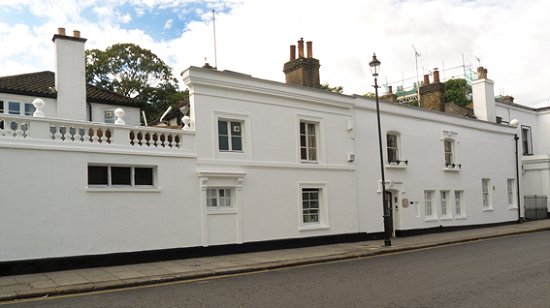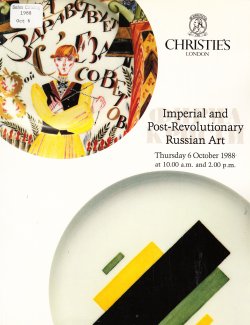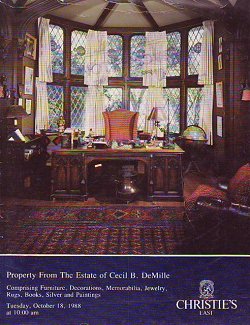The extra-special effects of Cecil B. DeMille are being sold by Christie’s New York this month. Andrew Solomon plays with them; but first he visits the Chelsea Arts Club.
Artists do not live in the Home Counties because they revel in angst. Artists do not wear properly made suits because they have higher ideals than accountants have. Artists dance extravagantly because their characters know no restraint, and they laugh madly because they have lost the strength to weep. Artists tinge their most mundane activities with irony, and know neither the peace of the Sainsbury’s queue nor the solemn rest of the back seat of a taxi. Artists, in short, are a problematic lot who spurn life’s simplest dignities. But one ought always to remember that they do not spurn life’s passions. Artists gamble and smoke and drink and are otherwise irresponsible and Bohemian. Or so, at least, tradition would have it. And tradition, which weighs no less heavily on British artists than on the rest of the British population, has led them to institutionalise their Bohemianism, concentrating their whisky, whimsy, and a horrifying amount of smoke in one verdant corner of Chelsea, called the Chelsea Arts Club.

The Chelsea Arts Club
We are in the Eighties indeed. Artists who for many years would have spurned any connection to an institution whose primary function is social, and who for many years thereafter would carefully have avoided notifying the public of their membership, are now rather proud to be part of art’s nobility, and are cheerily painting works for the Chelsea Arts Club sale, to be held on 24 October by Sotheby’s. The artists, far from suggesting that their higher calling has given them priorities to supersede their affection for the charming spot where, garbed in painters’ smocks, they drink into the morning, have come rallying to the support of the Chelsea Arts Club in its hour of moderate need. It is hoped that the sale will realise £450,000, though it looks as if it could easily net substantially more. The larger part of the proceeds from the sale will allow the club to repay the loan with which its lease was bought last year, and the extra profit will be used to establish a Charitable Trust Fund, which, like the Distressed Gentlefolks Aid Association, will benefit a segment of the population whose deprivation, though genuine, does not always qualify for Government relief in these Thatcherite days.
The lease has been purchased for 99 years, that artists may have a place of their own until 2086, by which time, the nihilists among the members may well point out, the world may have come to an end. If it has not, the Chelsea Arts Club will surely be an important part of it, for it cannot be denied that one of the failings of art in our post-modern age is that it tends to rely on entirely individual visions, and that the club represents a startling spur of unity. Movements come and go — and movement, of course, require a modicum of communication — but essentially the contemporary artist tends all too frequently to work in a vacuum, observing the work of his peers only from a safe distance. For the modern critic who trembles at the unmanageable task of creating a canon, the Chelsea Arts Club sale comes like a gift. Surely, if one seeks evidence that the artistic community in Britain has a self-defining hierarchy, one need look no further than there for the triumph of interconnectedness. One may rave about the contradictions that underlie the very existence of the club, but one recognises nonetheless that the sale will be among the major events of the London art world in the Eighties. A hefty proportion of the best artists in Britain are contributing work, and there is little doubt that a hefty proportion of the most art-worldly figures in Britain will materialise at the sale to buy.
The sale of contemporary art at auction is a newish phenomenon. The sale of contemporary art painted specifically to be sold at auction is a newer phenomenon. The sale of art by many important contemporary painters at an auction to which they have donated their works is the newest phenomenon of all. There are already pieces promised by nearly 300 artist-members, with many others “not promised but suggested positively” which are likely to materialise before the sale. The list of contributors is endearing in its eccentricity; artists of whom no one has ever heard — really no one, not ever — sit side by side with some of the greatest artists in England. As the list grows, of course, it becomes increasingly clear that there is too much material for one sale, and so the club, part of whose sanctity has always lain in its abstention from judgement, will have to move some pieces into a later sale. “These decisions,” explains Mirjana Winterbottom, the charming Dane behind the club and the sale, “we will leave in the hands of Sotheby’s, whose experts know so much more than we do.”
Mirjana Winterbottom — who seems to have thrown herself into the task of this sale with a combination of wild abandon and the will to organise — speaks airily of the Arts Club as “a lovely spot where artists talk of things other than their work, and where they drink, a refuge, a retreat that they need, a place where, when they are lonely, they can find companionship.” It may well be that, but as it now pokes an unhesitant toe into the world of the limelight, it reveals itself as rather more. Anyone not allergic to cigarette smoke who has gone for drinks at the Chelsea Arts Club on a spring afternoon can attest to the manifest charms of the place; they are old hat. But a place in whose name can be staged an event in which Barry Flanagan, Patrick Caulfield, John Piper, Patrick Procktor, Peter Blake and a host of others are enthusiastically in co-operation has proved us wrong in our assessment of the status of painting today. This remains the case even it, as one prominent artist commented, they “all have to suffer over whether go vie a bad work of art, which seems ungenerous and could be embarrassing, or to give a very good work of art, which seems like a bit of a waste, or to dig up some nice mediocre piece, which is hard if you feel strongly about everything you do, but which certainly makes most sense.” Good, bad, or indifferent, the works of art in this sale will have a place in history, and are worth buying for that reason alone. And the sale will surely be worth attending even if you have nothing to buy, nothing to sell, and less chance of being elected to membership in the club than a celluloid kitty in hell. Mirjana Winterbottom explains enthusiastically that “all the artists who are contributing will, I think, attend the sale and our party afterwards” — this will be the performance piece to top all performance pieces. Lord Gowrie, chairman of Sotheby’s, will be conducting the sale, providing, no doubt a final touch of elegance to an event in which art learns all its indulgences all over again.

While Sotheby’s makes contemporary history with its Arts Club Sale, Christie’s is busy calling up old history with the sweetly aristocratic sentimentality it has mastered so well. The Sotheby’s sale of contemporary Soviet painting in July received much coverage as a landmark event; on 6 October Christie’s will be holding a sale of Imperial and Post-Revolutionary Russian Art, which features a healthy mixture of Catherine the Great’s tableware and Contructivist graphic art. It is difficult to say whether Fabergé would be more startled to see himself sold by Lissitzky’s side than Lissitzky would be to find himself in with Fabergé; and in a way the oddity of this sale is that, in this era in which we are coming to accept the Russians on their own terms, works ideologically so violently opposed should be thrown together under the great brand of the double-headed eagle and the hammer and sickle. This does not, however, contravene the magnificence of the material in the sale, especially in the decorative arts. O ye new-born aficionados of Russia, take note — here are Rodchenko collages, Imperial and Lomonossov porcelain, avant-garde books by Malevich and Larianov, and several kovshs (symbolic peasant ladles) given by Elizabeth I to worthy courtiers.
Christie’s New York, meanwhile, has dredged up figures from the days when the land of the stars and stripes was at its glamrous best, the days when everyone had a little culture and a lot of sophistication, when women sang and men raved under a story-book moon which spelled out their destiny. On 18 October Christie’s East will sell the estate of Cecil B. DeMille, whose legendary grand films are the apotheosis of Hollywood grandeur from the days before tinsel town really went tinsel. He died in 1959, but his granddaughter Cecilia DeMille Presley kept the house, hoping that it would eventually be turned into a museum. This year, she decided to hold some of the movie memorabilia and to sell off everything else — which makes up quite a stunning and rather a startling assortment of stuff. There are the usual splendours in the decorative arts, most of them large and dominating pieces of furniture of the relentless oak school. There’s a Norman Rockwell painting of Victor Mature as Samson in the film Samson and Delilah. There are fine religious texts from DeMille’s library.

But most gripping, of course, is the film memorabilia. The strong box from Don’t Change Your Husband is on offer, and is quite spectacular — though rather cumbersome, as strong boxes are wont to be. The high point of the sale is surely the pair of earrings and the necklace worn by Anne Baxter when she played Nefertiti in The Ten Commandments. The set is made of “original scarabs from ancient Egypt” (or perhaps ancient scarabs from the original Egypt?) and is estimated at a scant $2,000 to $3,000.
The sale will have a backdrop of related activity, which is fast becoming a hallmark of Christie’s New York. Cecil B. DeMille invented the term “sex-appeal” for Geraldine Farrar and Gloria Swanson; one wonders whether he could have found so apt a name for the appeal he carries right now for an impressionable public. For the week preceding the sale, there will be a DeMille film festival sponsored by Christie’s, with old-style tickets to seduce those who thought they could suppress their nostalgia during the films themselves. Once again one wonders if lives lived to the fullest will sell for the most.
Nostalgia wears a more pedestrian — but no less endearing — face at Phillips and at Bonhams this months. Phillips’s sale of fine toys on 5 October includes the usual run of model trains and beautiful dolls from the beginning of the century, but its highlight is a battery-operated edition of the robot from The Forbidden Planet, known by the family that loved him as Robbie the Robot. This 33-centimetre miracle of Fifties engineering was made by Nomura of Japan, and is one of the earliest robots made for general consumption; his price has escalated to an estimated £500 to £1,000, bringing home once more the prohibitive price of help these days. Hold on to your original Mr. Potatohead if he’s still on hand and by the 21st century he might pay for a car, a flat, a country estate — but probably not for Robbie, who will have passed to such an astronomical value by that time as to have left this country altogether.
Bonhams is beginning to sell the pictorial archive of the Illustrated London News from now until September 1989, and on 12 October will hold the first in this long series of sales, of the Transport segment of the archive. True and fabulous versions of aeroplanes will be included. Perhaps the lucky purchaser of Robbie the Robot can find an appropriate space vehicle for him at Bonhams.

Mechanized robot by Nomura.











